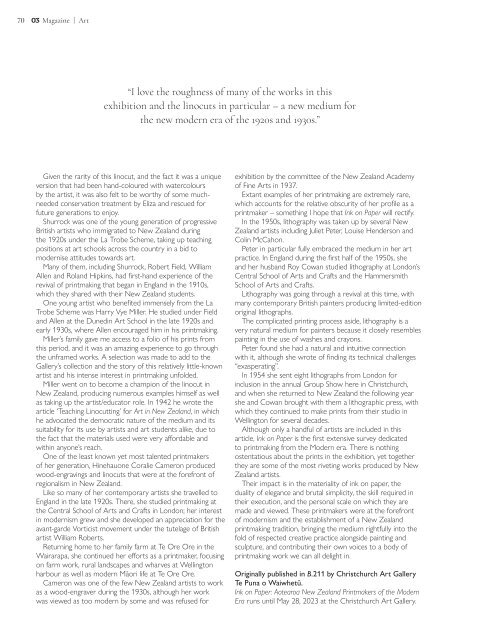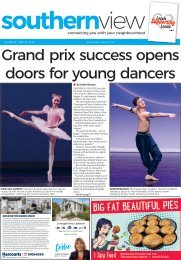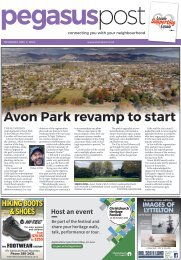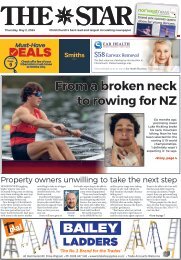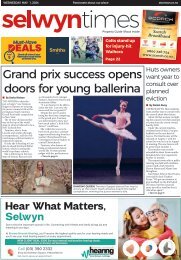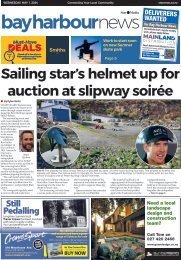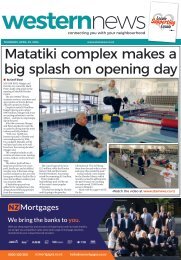03 Magazine: March 31, 2023
Create successful ePaper yourself
Turn your PDF publications into a flip-book with our unique Google optimized e-Paper software.
70 <strong>Magazine</strong> | Art<br />
“I love the roughness of many of the works in this<br />
exhibition and the linocuts in particular – a new medium for<br />
the new modern era of the 1920s and 1930s.”<br />
Given the rarity of this linocut, and the fact it was a unique<br />
version that had been hand-coloured with watercolours<br />
by the artist, it was also felt to be worthy of some muchneeded<br />
conservation treatment by Eliza and rescued for<br />
future generations to enjoy.<br />
Shurrock was one of the young generation of progressive<br />
British artists who immigrated to New Zealand during<br />
the 1920s under the La Trobe Scheme, taking up teaching<br />
positions at art schools across the country in a bid to<br />
modernise attitudes towards art.<br />
Many of them, including Shurrock, Robert Field, William<br />
Allen and Roland Hipkins, had first-hand experience of the<br />
revival of printmaking that began in England in the 1910s,<br />
which they shared with their New Zealand students.<br />
One young artist who benefited immensely from the La<br />
Trobe Scheme was Harry Vye Miller. He studied under Field<br />
and Allen at the Dunedin Art School in the late 1920s and<br />
early 1930s, where Allen encouraged him in his printmaking.<br />
Miller’s family gave me access to a folio of his prints from<br />
this period, and it was an amazing experience to go through<br />
the unframed works. A selection was made to add to the<br />
Gallery’s collection and the story of this relatively little-known<br />
artist and his intense interest in printmaking unfolded.<br />
Miller went on to become a champion of the linocut in<br />
New Zealand, producing numerous examples himself as well<br />
as taking up the artist/educator role. In 1942 he wrote the<br />
article ‘Teaching Linocutting’ for Art in New Zealand, in which<br />
he advocated the democratic nature of the medium and its<br />
suitability for its use by artists and art students alike, due to<br />
the fact that the materials used were very affordable and<br />
within anyone’s reach.<br />
One of the least known yet most talented printmakers<br />
of her generation, Hinehauone Coralie Cameron produced<br />
wood-engravings and linocuts that were at the forefront of<br />
regionalism in New Zealand.<br />
Like so many of her contemporary artists she travelled to<br />
England in the late 1920s. There, she studied printmaking at<br />
the Central School of Arts and Crafts in London; her interest<br />
in modernism grew and she developed an appreciation for the<br />
avant-garde Vorticist movement under the tutelage of British<br />
artist William Roberts.<br />
Returning home to her family farm at Te Ore Ore in the<br />
Wairarapa, she continued her efforts as a printmaker, focusing<br />
on farm work, rural landscapes and wharves at Wellington<br />
harbour as well as modern Māori life at Te Ore Ore.<br />
Cameron was one of the few New Zealand artists to work<br />
as a wood-engraver during the 1930s, although her work<br />
was viewed as too modern by some and was refused for<br />
exhibition by the committee of the New Zealand Academy<br />
of Fine Arts in 1937.<br />
Extant examples of her printmaking are extremely rare,<br />
which accounts for the relative obscurity of her profile as a<br />
printmaker – something I hope that Ink on Paper will rectify.<br />
In the 1950s, lithography was taken up by several New<br />
Zealand artists including Juliet Peter, Louise Henderson and<br />
Colin McCahon.<br />
Peter in particular fully embraced the medium in her art<br />
practice. In England during the first half of the 1950s, she<br />
and her husband Roy Cowan studied lithography at London’s<br />
Central School of Arts and Crafts and the Hammersmith<br />
School of Arts and Crafts.<br />
Lithography was going through a revival at this time, with<br />
many contemporary British painters producing limited-edition<br />
original lithographs.<br />
The complicated printing process aside, lithography is a<br />
very natural medium for painters because it closely resembles<br />
painting in the use of washes and crayons.<br />
Peter found she had a natural and intuitive connection<br />
with it, although she wrote of finding its technical challenges<br />
“exasperating”.<br />
In 1954 she sent eight lithographs from London for<br />
inclusion in the annual Group Show here in Christchurch,<br />
and when she returned to New Zealand the following year<br />
she and Cowan brought with them a lithographic press, with<br />
which they continued to make prints from their studio in<br />
Wellington for several decades.<br />
Although only a handful of artists are included in this<br />
article, Ink on Paper is the first extensive survey dedicated<br />
to printmaking from the Modern era. There is nothing<br />
ostentatious about the prints in the exhibition, yet together<br />
they are some of the most riveting works produced by New<br />
Zealand artists.<br />
Their impact is in the materiality of ink on paper, the<br />
duality of elegance and brutal simplicity, the skill required in<br />
their execution, and the personal scale on which they are<br />
made and viewed. These printmakers were at the forefront<br />
of modernism and the establishment of a New Zealand<br />
printmaking tradition, bringing the medium rightfully into the<br />
fold of respected creative practice alongside painting and<br />
sculpture, and contributing their own voices to a body of<br />
printmaking work we can all delight in.<br />
Originally published in B.211 by Christchurch Art Gallery<br />
Te Puna o Waiwhetū.<br />
Ink on Paper: Aotearoa New Zealand Printmakers of the Modern<br />
Era runs until May 28, <strong>2023</strong> at the Christchurch Art Gallery.


